TOYOTA COROLLA 2022 Owners Manual (in English)
Manufacturer: TOYOTA, Model Year: 2022, Model line: COROLLA, Model: TOYOTA COROLLA 2022Pages: 678, PDF Size: 147.24 MB
Page 281 of 678
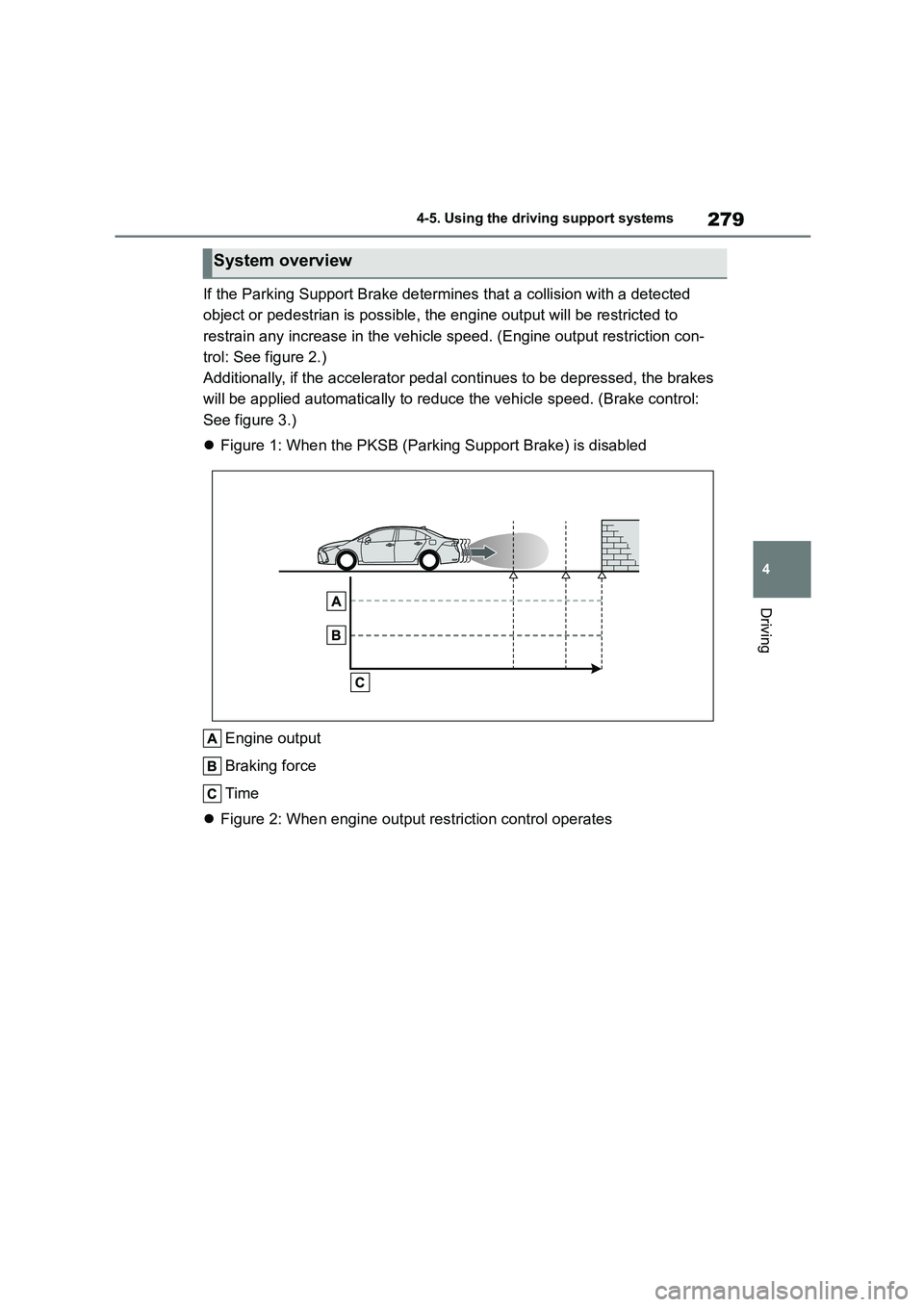
279
4
4-5. Using the driving support systems
Driving
If the Parking Supp ort Brake determines that a collision with a detected
object or pedestrian is possible, the engine output will be restricted to
restrain any increase in the vehicle sp eed. (Engine output restriction con-
trol: See figure 2.)
Additionally, if the accelerator pedal continues to be depressed, the brakes
will be applied automatica lly to reduce the vehicle speed. (Brake control:
See figure 3.)
Figure 1: When the PKSB (Parking Support Brake) is disabled
Engine output
Braking force
Time
Figure 2: When engine output restriction control operates
System overview
Page 282 of 678
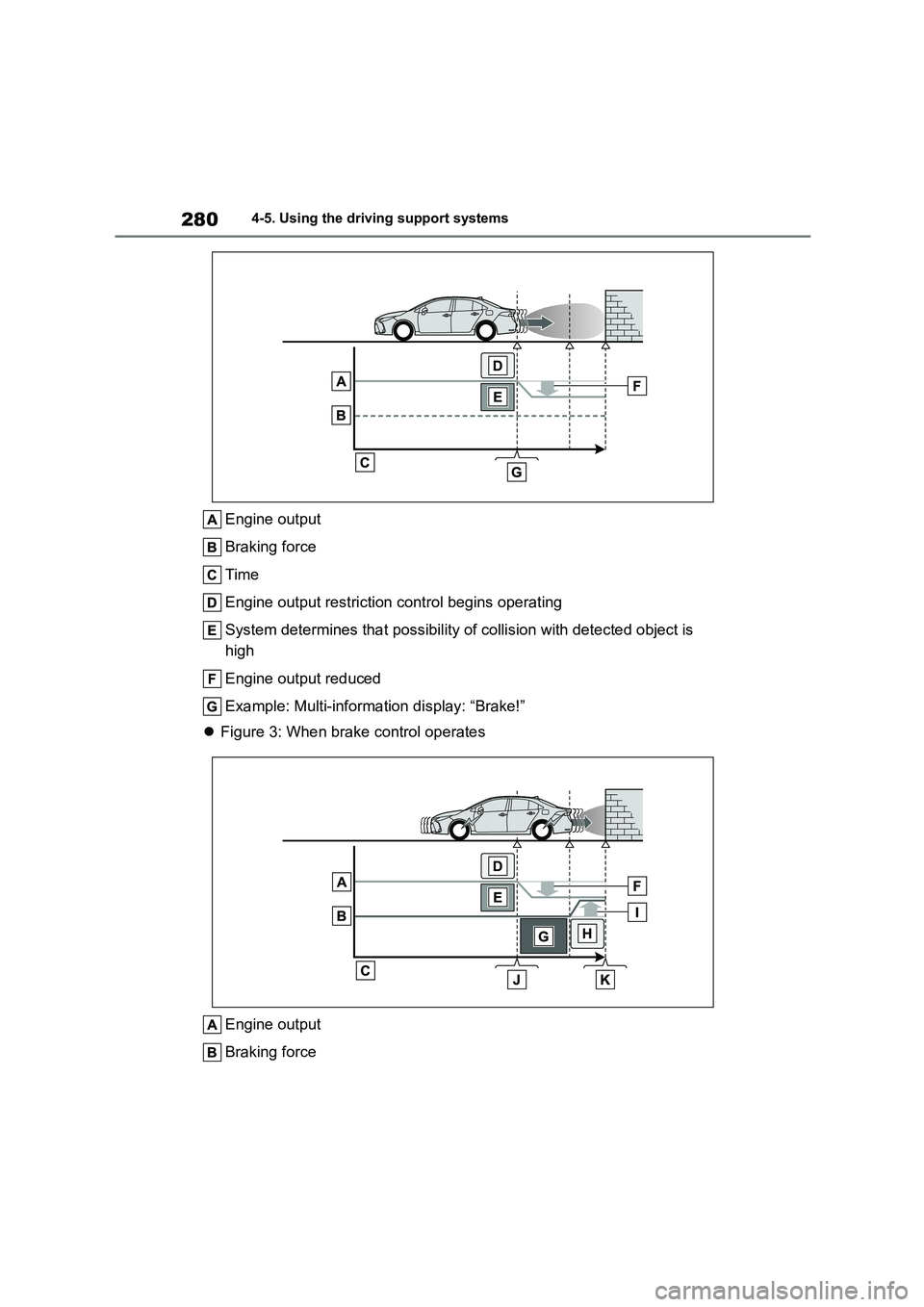
2804-5. Using the driving support systems
Engine output
Braking force
Time
Engine output restriction control begins operating
System determines that possibility of collision with detected object is
high
Engine output reduced
Example: Multi-informat ion display: “Brake!”
Figure 3: When brake control operates
Engine output
Braking force
Page 283 of 678
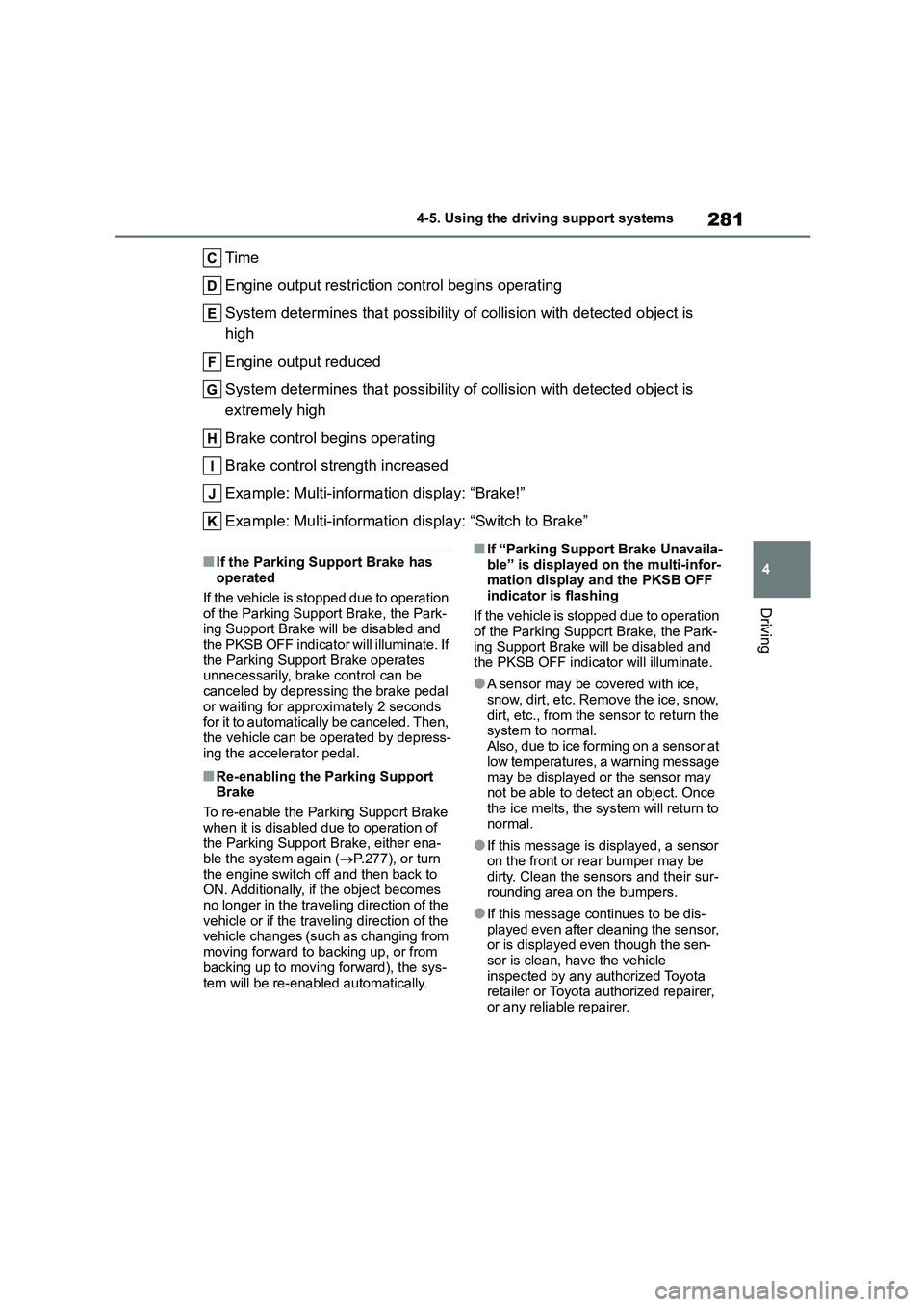
281
4
4-5. Using the driving support systems
Driving
Time
Engine output restriction control begins operating
System determines that possibility of collision with detected object is
high
Engine output reduced
System determines that possibility of collision with detected object is
extremely high
Brake control begins operating
Brake control strength increased
Example: Multi-informat ion display: “Brake!”
Example: Multi-information di splay: “Switch to Brake”
■If the Parking Support Brake has operated
If the vehicle is stopped due to operation
of the Parking Support Brake, the Park- ing Support Brake will be disabled and
the PKSB OFF indicator will illuminate. If
the Parking Support Brake operates unnecessarily, brake control can be
canceled by depressing the brake pedal
or waiting for approximately 2 seconds for it to automatically be canceled. Then,
the vehicle can be operated by depress-
ing the accelerator pedal.
■Re-enabling the Parking Support Brake
To re-enable the Parking Support Brake
when it is disabled due to operation of the Parking Support Brake, either ena-
ble the system again ( P.277), or turn
the engine switch off and then back to ON. Additionally, if the object becomes
no longer in the traveling direction of the
vehicle or if the traveling direction of the vehicle changes (such as changing from
moving forward to backing up, or from
backing up to moving forward), the sys-
tem will be re-enabled automatically.
■If “Parking Support Brake Unavaila-
ble” is displayed on the multi-infor- mation display and the PKSB OFF
indicator is flashing
If the vehicle is stopped due to operation of the Parking Support Brake, the Park-
ing Support Brake will be disabled and
the PKSB OFF indicator will illuminate.
●A sensor may be covered with ice,
snow, dirt, etc. Remove the ice, snow, dirt, etc., from the sensor to return the
system to normal.
Also, due to ice forming on a sensor at low temperatures, a warning message
may be displayed or the sensor may
not be able to detect an object. Once the ice melts, the system will return to
normal.
●If this message is displayed, a sensor
on the front or rear bumper may be
dirty. Clean the sensors and their sur- rounding area on the bumpers.
●If this message continues to be dis-played even after cleaning the sensor,
or is displayed even though the sen-
sor is clean, have the vehicle inspected by any authorized Toyota
retailer or Toyota authorized repairer,
or any reliable repairer.
Page 284 of 678
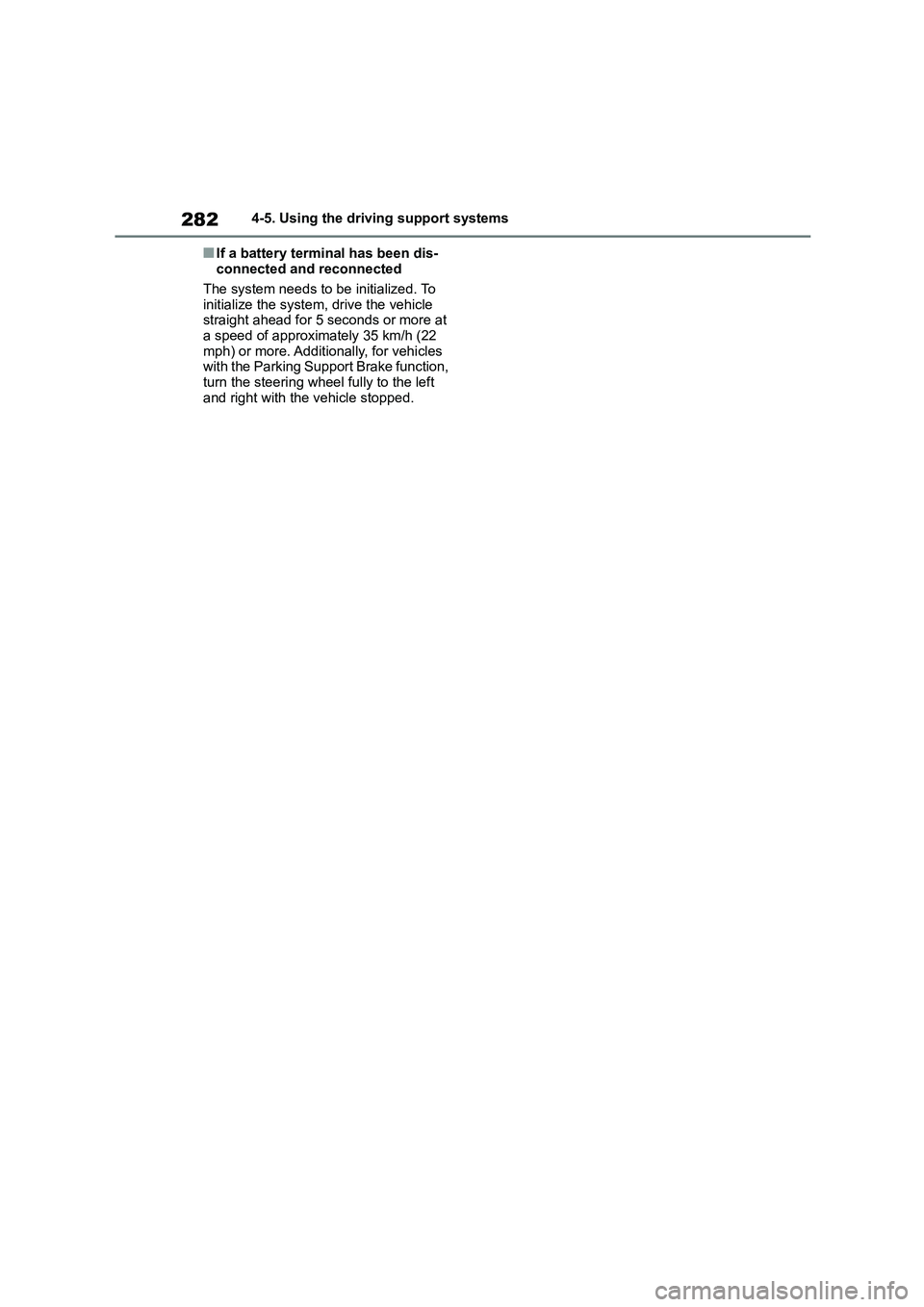
2824-5. Using the driving support systems
■If a battery terminal has been dis-
connected and reconnected
The system needs to be initialized. To
initialize the system, drive the vehicle
straight ahead for 5 seconds or more at a speed of approximately 35 km/h (22
mph) or more. Additionally, for vehicles
with the Parking Support Brake function, turn the steering wheel fully to the left
and right with the vehicle stopped.
Page 285 of 678
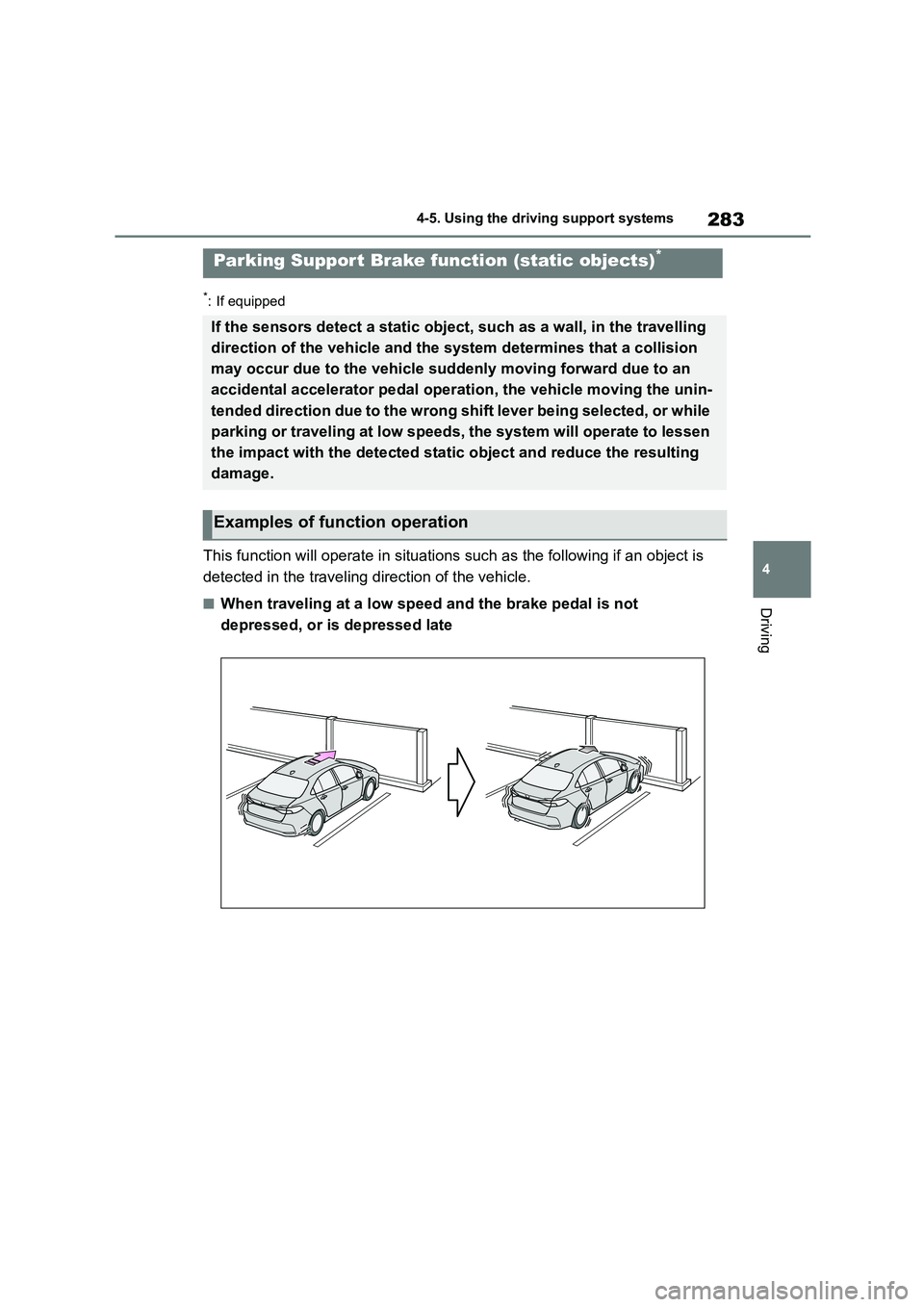
283
4
4-5. Using the driving support systems
Driving
*: If equipped
This function will operate in situations such as the following if an object is
detected in the traveling direction of the vehicle.
■When traveling at a low speed and the brake pedal is not
depressed, or is depressed late
Parking Suppor t Brake function (static objects)*
If the sensors detect a static object, such as a wall, in the travelling
direction of the vehicle and the system determines that a collision
may occur due to the vehicle suddenly moving forward due to an
accidental accelerator pedal oper ation, the vehicle moving the unin-
tended direction due to the wrong shift lever being selected, or while
parking or traveling at low speeds, the system will operate to lessen
the impact with the detected static object and reduce the resulting
damage.
Examples of function operation
Page 286 of 678
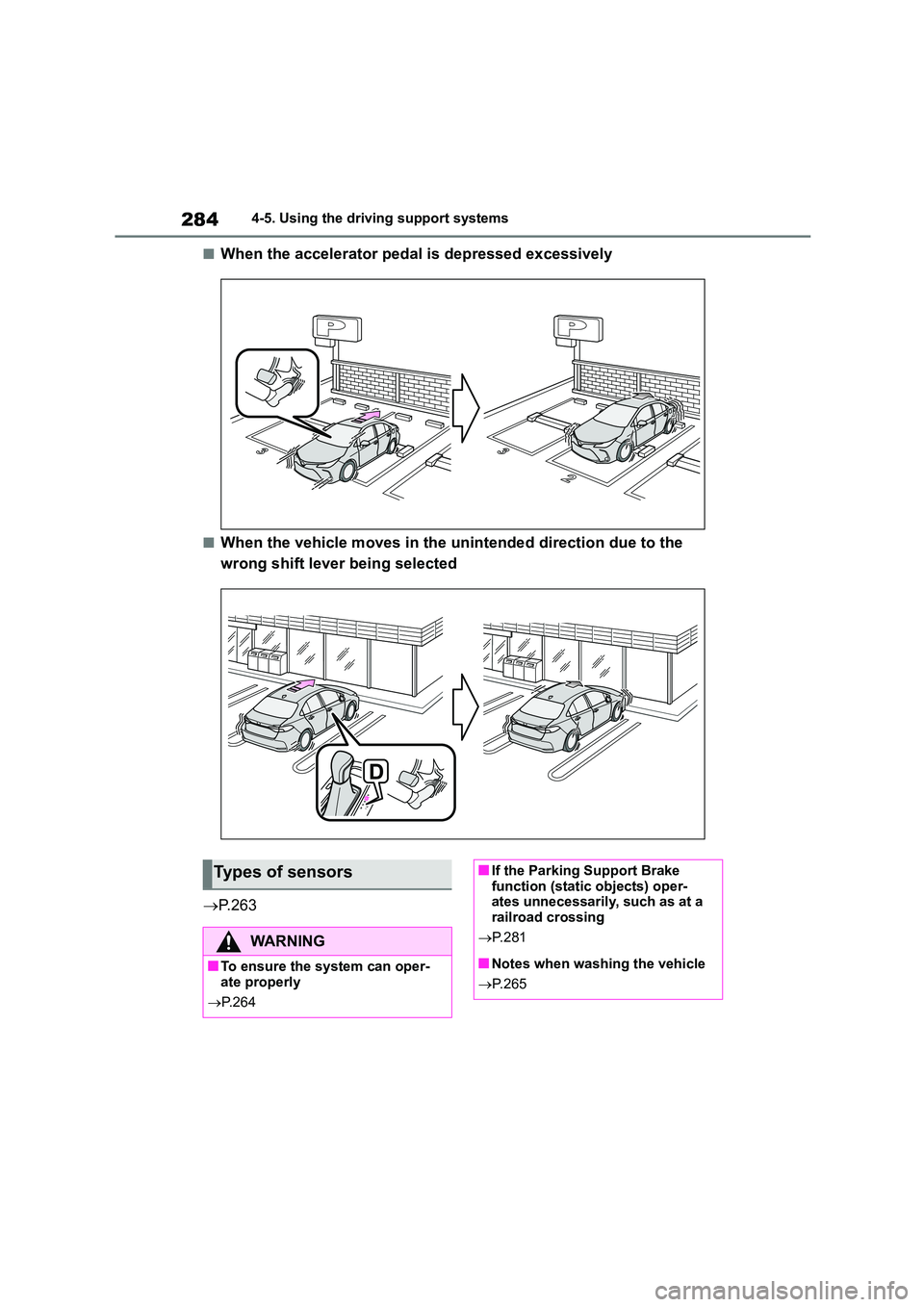
2844-5. Using the driving support systems
■When the accelerator pedal is depressed excessively
■When the vehicle moves in the unintended direction due to the
wrong shift lever being selected
P. 2 6 3
Types of sensors
WA R N I N G
■To ensure the system can oper- ate properly
P.264
■If the Parking Support Brake function (static objects) oper-
ates unnecessarily, such as at a
railroad crossing
P. 2 8 1
■Notes when washing the vehicle
P. 2 6 5
Page 287 of 678
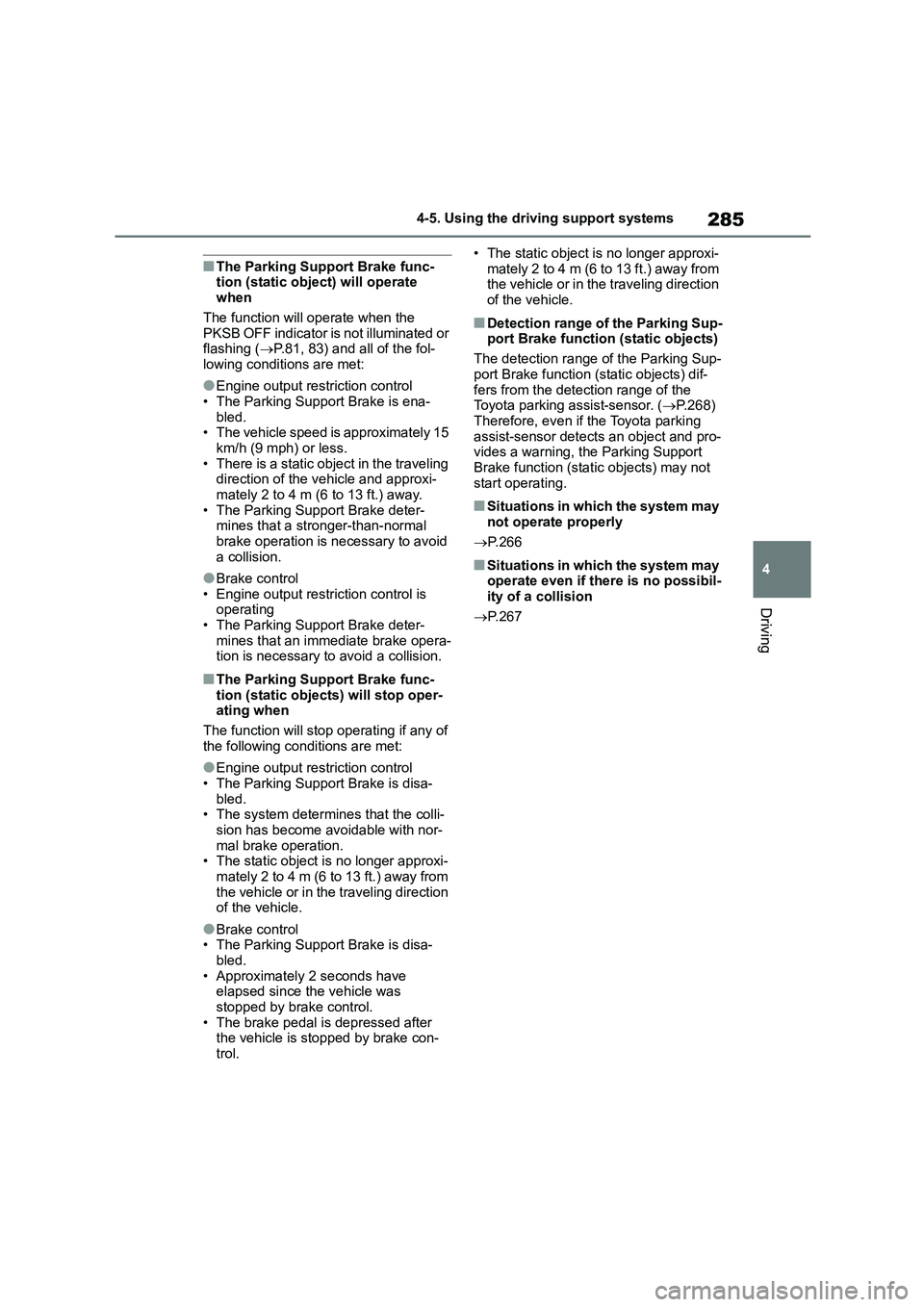
285
4
4-5. Using the driving support systems
Driving
■The Parking Support Brake func- tion (static object) will operate
when
The function will operate when the PKSB OFF indicator is not illuminated or
flashing ( P.81, 83) and all of the fol-
lowing conditions are met:
●Engine output restriction control
• The Parking Support Brake is ena- bled.
• The vehicle speed is approximately 15
km/h (9 mph) or less. • There is a static object in the traveling
direction of the vehicle and approxi-
mately 2 to 4 m (6 to 13 ft.) away. • The Parking Support Brake deter-
mines that a stronger-than-normal
brake operation is necessary to avoid a collision.
●Brake control• Engine output restriction control is
operating
• The Parking Support Brake deter- mines that an immediate brake opera-
tion is necessary to avoid a collision.
■The Parking Support Brake func-
tion (static objects) will stop oper- ating when
The function will stop operating if any of
the following conditions are met:
●Engine output restriction control
• The Parking Support Brake is disa-
bled. • The system determines that the colli-
sion has become avoidable with nor-
mal brake operation. • The static object is no longer approxi-
mately 2 to 4 m (6 to 13 ft.) away from
the vehicle or in the traveling direction of the vehicle.
●Brake control• The Parking Support Brake is disa-
bled.
• Approximately 2 seconds have elapsed since the vehicle was
stopped by brake control.
• The brake pedal is depressed after the vehicle is stopped by brake con-
trol.
• The static object is no longer approxi-
mately 2 to 4 m (6 to 13 ft.) away from the vehicle or in the traveling direction
of the vehicle.
■Detection range of the Parking Sup-
port Brake function (static objects)
The detection range of the Parking Sup-
port Brake function (static objects) dif-
fers from the detection range of the Toyota parking assist-sensor. ( P.268)
Therefore, even if the Toyota parking
assist-sensor detects an object and pro- vides a warning, the Parking Support
Brake function (static objects) may not
start operating.
■Situations in which the system may not operate properly
P. 2 6 6
■Situations in which the system may
operate even if there is no possibil- ity of a collision
P. 2 6 7
Page 288 of 678
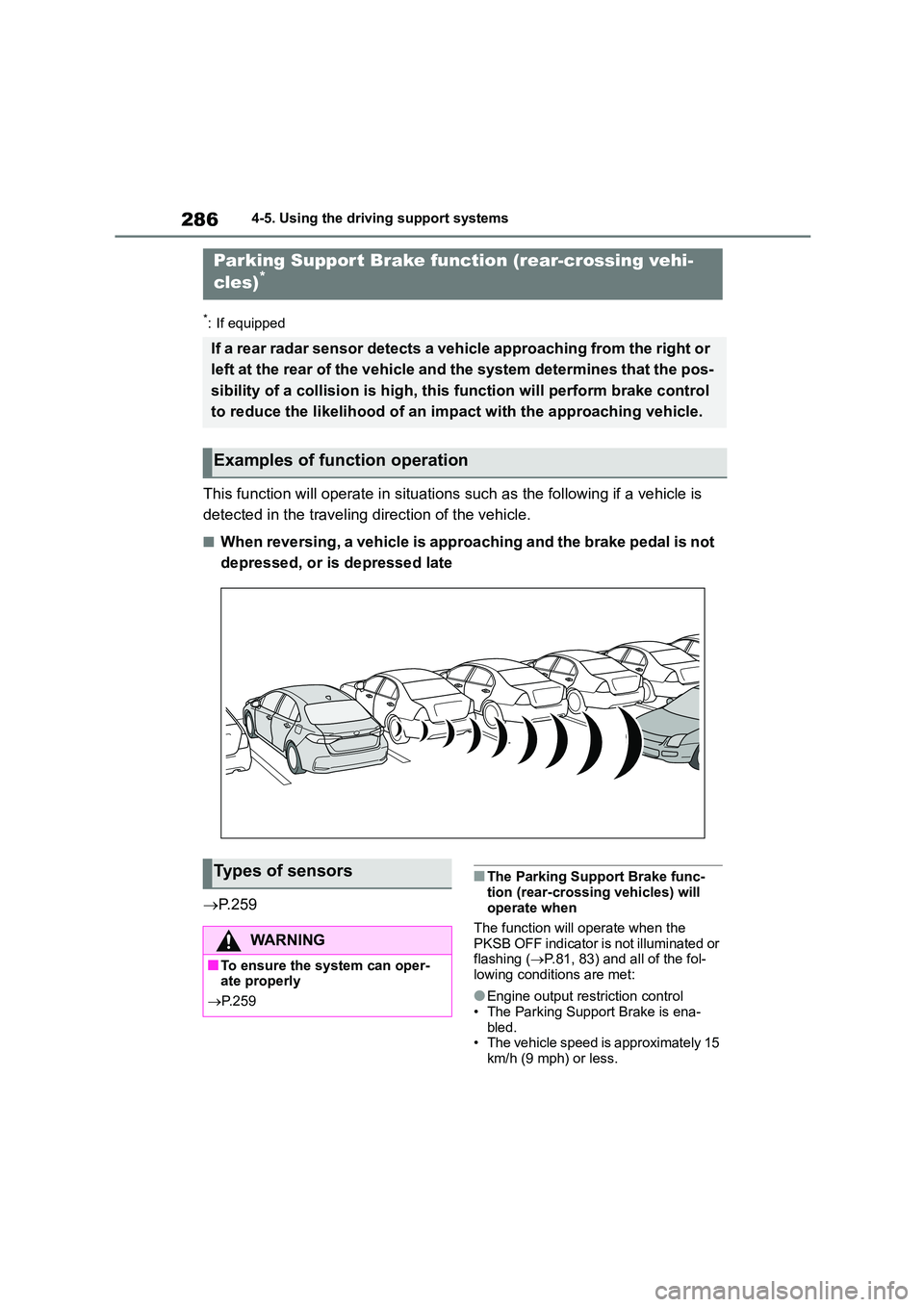
2864-5. Using the driving support systems
*: If equipped
This function will operate in situations such as the following if a vehicle is
detected in the traveling direction of the vehicle.
■When reversing, a vehicle is approaching and the brake pedal is not
depressed, or is depressed late
P. 2 5 9
■The Parking Support Brake func-
tion (rear-crossing vehicles) will operate when
The function will operate when the
PKSB OFF indicator is not illuminated or flashing ( P.81, 83) and all of the fol-
lowing conditions are met:
●Engine output restriction control • The Parking Support Brake is ena-
bled.
• The vehicle speed is approximately 15 km/h (9 mph) or less.
Parking Suppor t Brake function (rear-crossing vehi-
cles)*
If a rear radar sensor detects a vehicle approaching from the right or
left at the rear of the vehicle and the system determines that the pos-
sibility of a collision is high, this function will perform brake control
to reduce the likelihood of an impact with the approaching vehicle.
Examples of function operation
Types of sensors
WA R N I N G
■To ensure the system can oper-
ate properly
P.259
Page 289 of 678
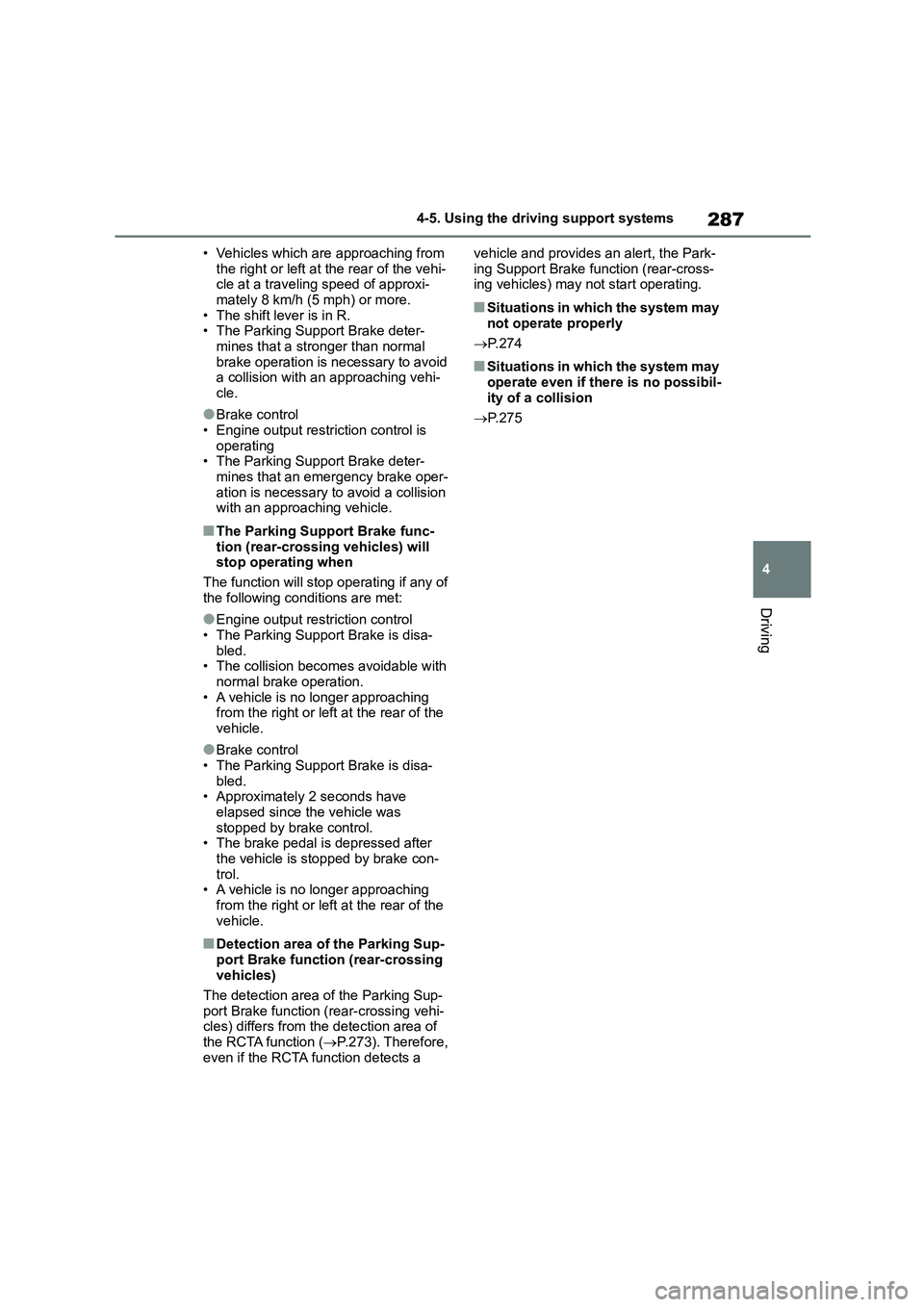
287
4
4-5. Using the driving support systems
Driving
• Vehicles which are approaching from
the right or left at the rear of the vehi- cle at a traveling speed of approxi-
mately 8 km/h (5 mph) or more.
• The shift lever is in R. • The Parking Support Brake deter-
mines that a stronger than normal
brake operation is necessary to avoid a collision with an approaching vehi-
cle.
●Brake control
• Engine output restriction control is
operating • The Parking Support Brake deter-
mines that an emergency brake oper-
ation is necessary to avoid a collision with an approaching vehicle.
■The Parking Support Brake func-
tion (rear-crossing vehicles) will
stop operating when
The function will stop operating if any of
the following conditions are met:
●Engine output restriction control
• The Parking Support Brake is disa-
bled. • The collision becomes avoidable with
normal brake operation.
• A vehicle is no longer approaching from the right or left at the rear of the
vehicle.
●Brake control
• The Parking Support Brake is disa-
bled. • Approximately 2 seconds have
elapsed since the vehicle was
stopped by brake control. • The brake pedal is depressed after
the vehicle is stopped by brake con-
trol. • A vehicle is no longer approaching
from the right or left at the rear of the
vehicle.
■Detection area of the Parking Sup-
port Brake function (rear-crossing vehicles)
The detection area of the Parking Sup-
port Brake function (rear-crossing vehi- cles) differs from the detection area of
the RCTA function ( P.273). Therefore,
even if the RCTA function detects a
vehicle and provides an alert, the Park-
ing Support Brake function (rear-cross- ing vehicles) may not start operating.
■Situations in which the system may
not operate properly
P. 2 7 4
■Situations in which the system may operate even if there is no possibil-
ity of a collision
P. 2 7 5
Page 290 of 678
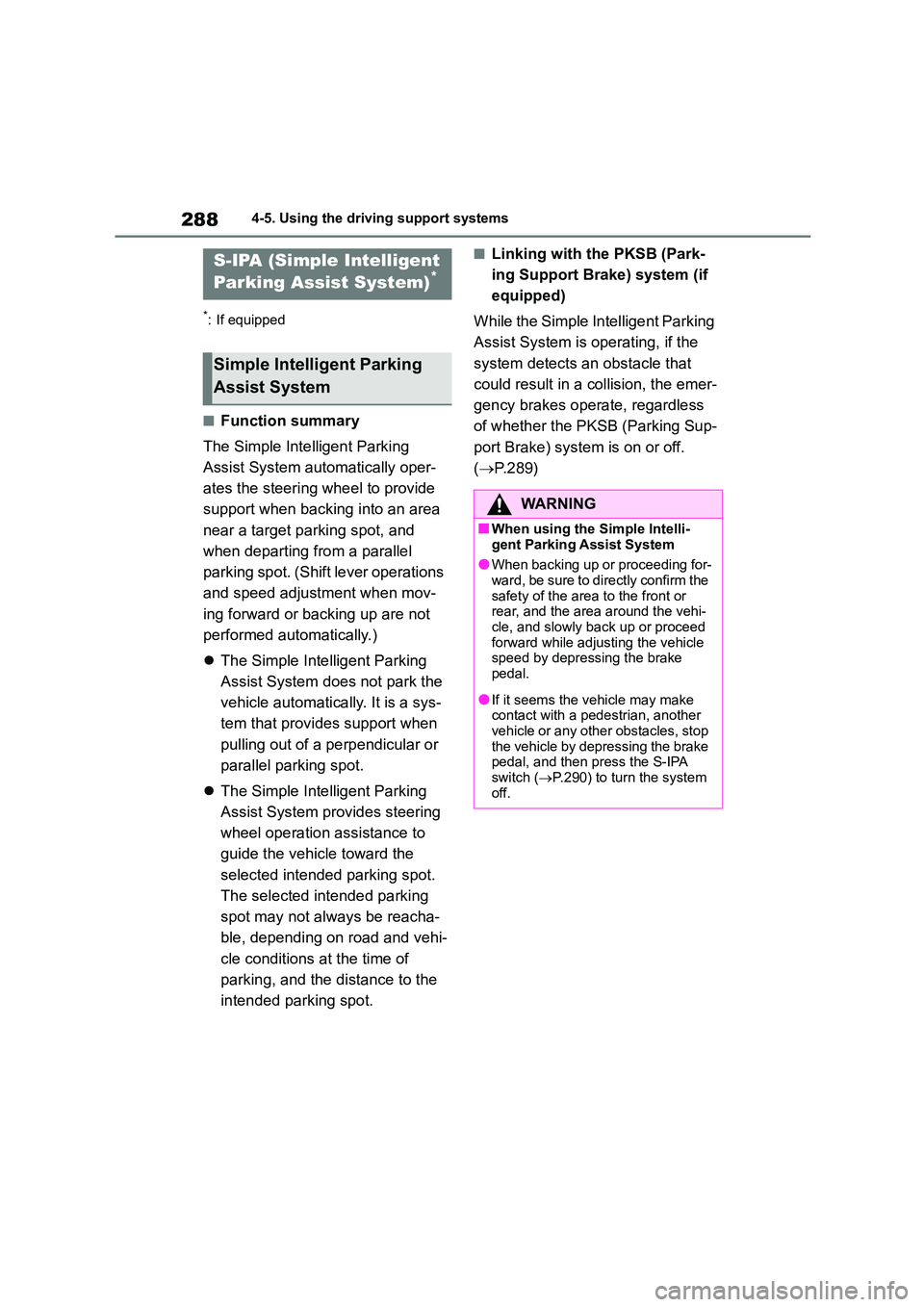
2884-5. Using the driving support systems
*: If equipped
■Function summary
The Simple Inte lligent Parking
Assist System automatically oper-
ates the steering wheel to provide
support when backing into an area
near a target parking spot, and
when departing from a parallel
parking spot. (Shift lever operations
and speed adjustment when mov-
ing forward or backing up are not
performed automatically.)
The Simple Intelligent Parking
Assist System does not park the
vehicle automatically. It is a sys-
tem that provides support when
pulling out of a perpendicular or
parallel parking spot.
The Simple Intelligent Parking
Assist System provides steering
wheel operation assistance to
guide the vehicle toward the
selected intended parking spot.
The selected intended parking
spot may not always be reacha-
ble, depending on road and vehi-
cle conditions at the time of
parking, and the distance to the
intended parking spot.
■Linking with the PKSB (Park-
ing Support Brake) system (if
equipped)
While the Simple Intelligent Parking
Assist System is operating, if the
system detects an obstacle that
could result in a collision, the emer-
gency brakes operate, regardless
of whether the PKSB (Parking Sup-
port Brake) system is on or off.
( P. 2 8 9 )
S-IPA (Simple Intelligent
Parking Assist System)*
Simple Intelligent Parking
Assist System
WA R N I N G
■When using the Simple Intelli-
gent Parking Assist System
●When backing up or proceeding for- ward, be sure to directly confirm the
safety of the area to the front or
rear, and the area around the vehi- cle, and slowly back up or proceed
forward while adjusting the vehicle
speed by depressing the brake pedal.
●If it seems the vehicle may make contact with a pedestrian, another
vehicle or any other obstacles, stop
the vehicle by depressing the brake pedal, and then press the S-IPA
switch ( P.290) to turn the system
off.